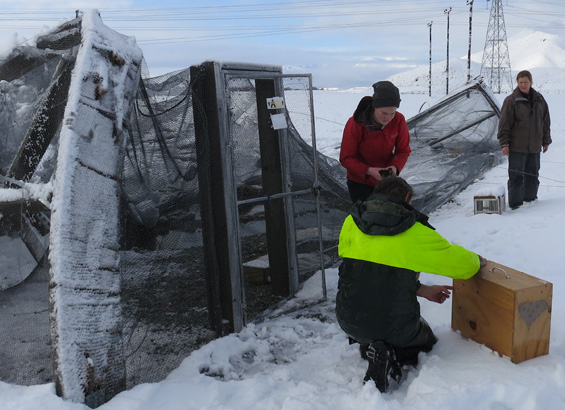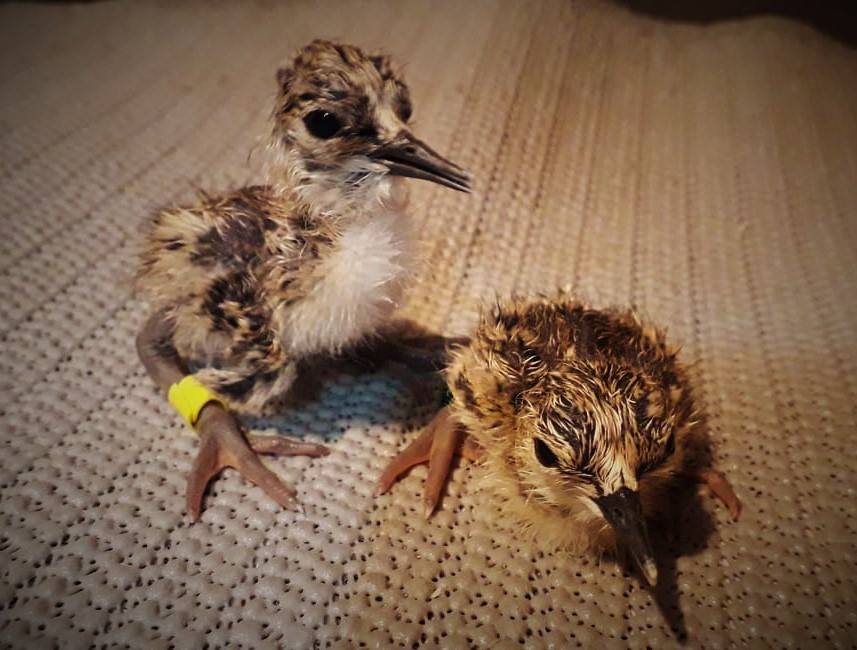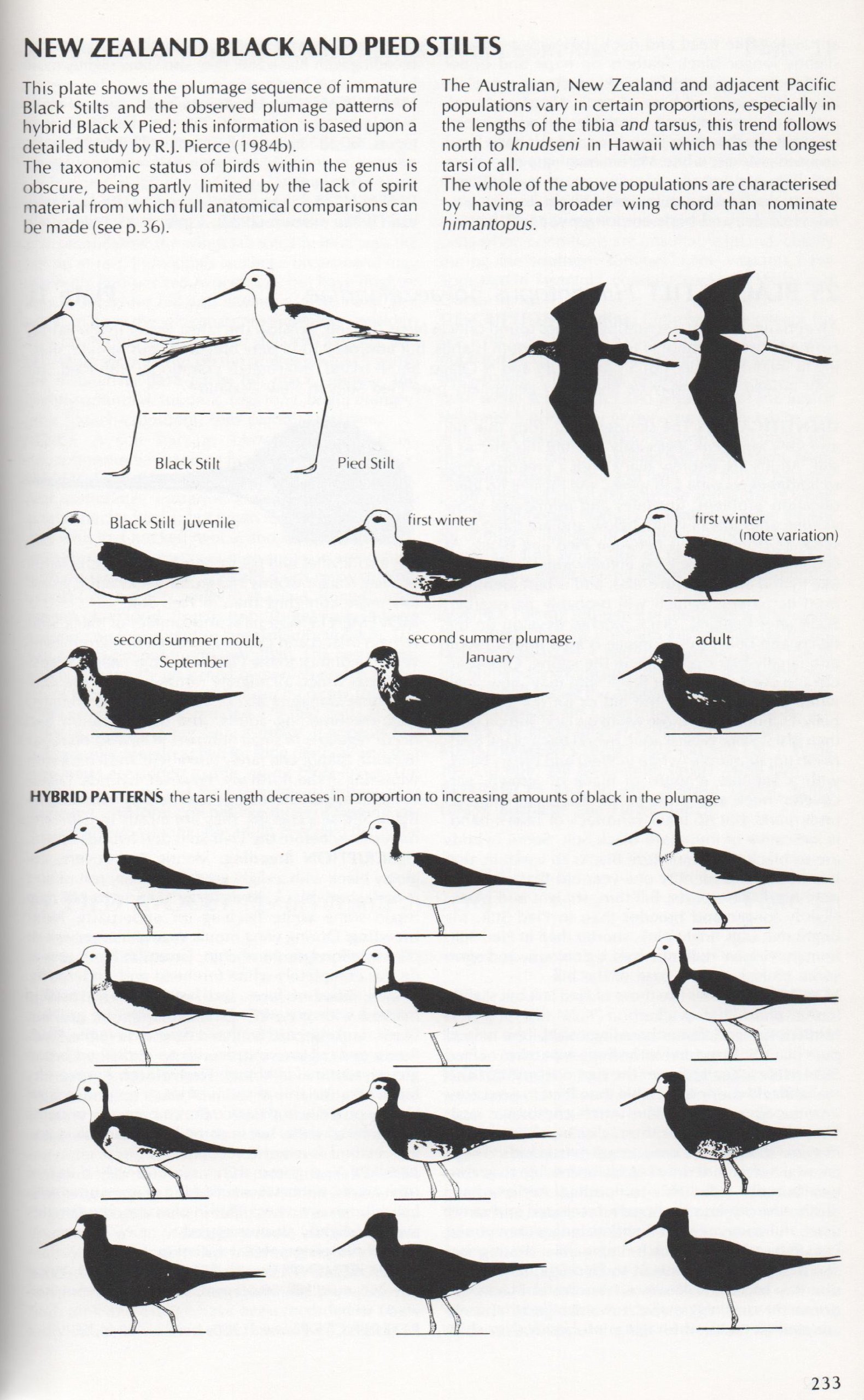Kakī | black stilt
Status: Nationally Critical
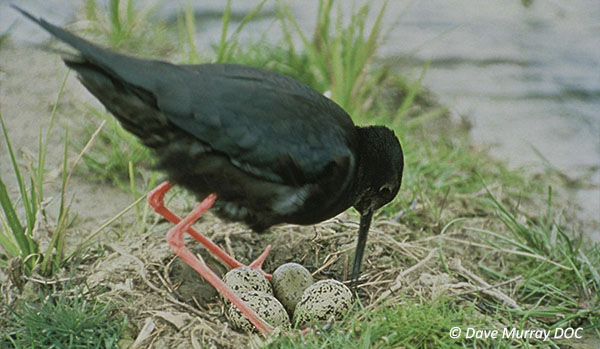
Once common throughout New Zealand, the black stilt | kakī is now restricted to the braided rivers and wetlands of the Mackenzie Basin, South Island (with a rare exception in the Ashley River estuary, however, it breeds with a poaka, creating a hybrid). Each pair of black stilt | kakī defends a territory, and nest alone on stable banks near the water in braided riverbeds, side streams, and swamps.
Description
Black stilt (Himantopus novaezelandiae) | kakī (Maori) are a compact bird about 40cm long. They are very distinctive with completely black plumage and long red legs. Endemic (unique) to New Zealand, they are regarded by Māori as a taonga species (living treasure). Kakī first breed when aged two or three years, and are known to mate for life. If they cannot find a kakī mate, they may sometimes breed with the pied stilt, a close relative. Juveniles are black and white, their plumage darkening to black as they reach maturity. This can lead to them being mistaken for pied stilts.
More information
- NZ Birds online (includes photos and sounds)
- iNaturalist
- Birdlife International (includes Google distribution map)
- NZ Birds
- The Encyclopedia of Earth: Ecology of the Black Stilt (Himantopus novaezelandiae) in a century of industrialization: consequences of indirect human impact
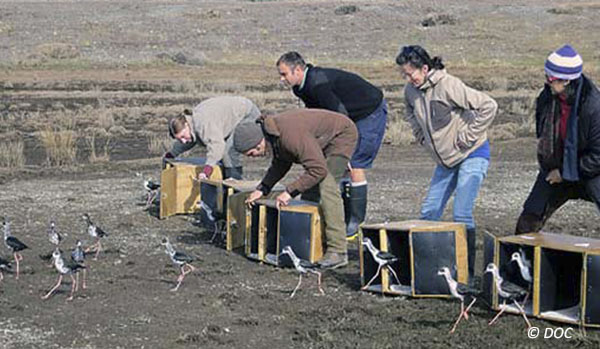
Conservation efforts
An intensive captive breeding programme has been underway for several years. The short videos on this page explain the problems and what’s being done to prevent the world’s most endangered wading bird from becoming extinct. The programme suffered a setback in 2015 when a snowstorm collapsed one of their aviaries in Twizel. A new aviary was built to replace it, and the programme continues at Twizel and at the Isaac Conservation Trust near Christchurch.
The Ashley-Rakahuri Rivercare group have also been undertaking predator and weed control in the hope of creating suitable habitat for the re-introduction of the birds into the estuary area.
The hybridisation issue
How do you save a species from extinction, when it’s already producing multiple hybrids by breeding with another, close but distinctly different species?
“The philosophical issue of what we are trying to conserve by management has always been around, but the issue becomes bigger with the application of genetical techniques. Are we trying to conserve a population? A species? Phenotype? Behaviour? Composite genotype? A lineage? As many of those things as possible? As introgression has already taken place, ‘purity’ of the species may be a lost cause.” – Wallis, 1999
The issue has raised multiple questions in conservation management, not the least of which is can (and should) you breed a ‘pure’ kakī from a hybrid kakī /poaka?
The results of subsequent research have led to some unexpected and interesting discoveries about the role of genomics in captive-bred programmes and overturns some long-held assumptions. See ‘References’ below.
This August 2019 video of kakī being released into the wild, also shows how difficult it is to distinguish hybrids from juveniles.
References and research
- See also Ecology/further information and references
- 2019: Galla et al; Reference Genomes from Distantly Related Species Can Be Used for Discovery of Single Nucleotide Polymorphisms to Inform Conservation Management Genes 2019, 10 (1), 9
- 2019: See also Genes Special Issue “Conservation Genetics and Genomics“
- 2017: Forsdick; Genome analysis of hybridisation between Kakī (Black Stilt) and Poaka (Pied Stilt) (BRaid seminar)
- 2017: Nelson (DOC); Update on the kakī recovery programme (BRaid seminar)
- 2016: Galla; Black stilt/kakī: a brief history of conservation genetic management and goals for genomic research (BRaid workshop)
- 2016: Nicholls; Site assessments of two Canterbury braided rivers to determine the suitability for reintroducing Kakī (Himantopus novaezelandiae) (BRaid workshop)
- 2011: Hagen et al; Conservation Genetic Management of A Critically Endangered New Zealand Endemic Bird: Minimizing Inbreeding In The Black Stilt (Himantopus novaezelandiae). The International Journal of Avian Science 153(3):556-561
- 2008: Steeves et al; Development of Polymorphic Microsatellite Markers For The New Zealand Black Stilt (Himantopus novaezelandiae) and Cross-Amplification In The Pied Stilt (Himantopus himantopus leucocephalus). Molecular Ecology Resources 8(5):1105-110
- 2005: Cameron et al; Improving predator capture rates: analysis of river margin trap site data in the Waitaki Basin, New Zealand New Zealand Journal of Ecology (open access PDF)
- 2002: Sanders & Maloney; Causes of Mortality At Nests of Ground-Nesting Birds In The Upper Waitaki Basin, South Island, New Zealand: A 5-Year Video Study. Biological Conservation 106(2):225-236
- 2001: Maloney & Murray; Kaki (Black Stilt) Recovery Plan 2001–2011. Department of Conservation, Wellington.
- 1999: Wallis; Genetic status of New Zealand black stilt (Himantopus novaezelandiae) and impact of hybridisation (DOC technical report)
- 1997: Millar et al; Captive Management and Molecular Sexing of Endangered Avian Species: An Application To The Black Stilt Himantopus novaezelandiae and Hybrids. Biological Conservation 82(1):81-86
- 1996: Pierce; Ecology and Management of The Black Stilt Himantopus novaezelandiae. Bird Conservation International 6(01):81-88.
- 1986: Pierce; Foraging responses of stilts (Himantopus spp.: Aves) to changes in behaviour and abundance of their riverbed prey New Zealand Journal of Marine and Freshwater Research (open access PDF)
- 1986: Differences in Susceptibility to Predation Between Pied and Black Stilts (Himantopus spp.). Auk 103(2): 273-280.
- 1984: Pierce; Plumage, Morphology and Hybridization of New Zealand Stilts Himantopus spp. Notornis 31(1): 106-130.
- 1982: Pierce; Comparative Ecological Study of the Pied and Black Stilts in South Canterbury. PhD thesis. University of Otago, Dunedin, New Zealand.

